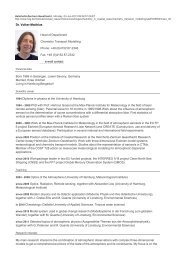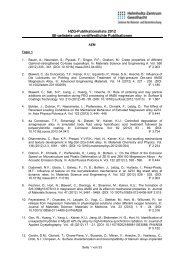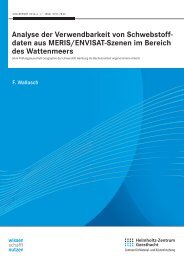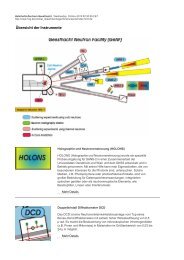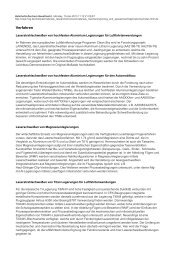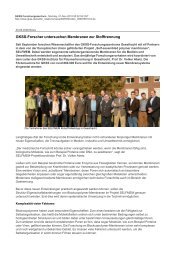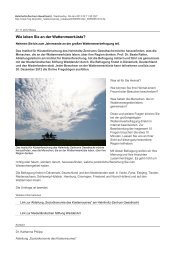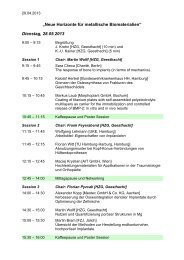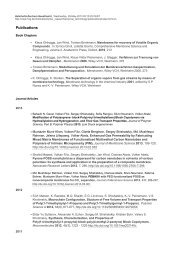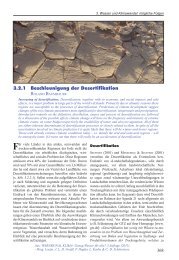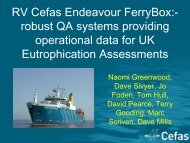High-resolution wave climate analysis in the Helgoland area - GKSS
High-resolution wave climate analysis in the Helgoland area - GKSS
High-resolution wave climate analysis in the Helgoland area - GKSS
Create successful ePaper yourself
Turn your PDF publications into a flip-book with our unique Google optimized e-Paper software.
Chapter 3<br />
Statistical-dynamical approach to <strong>the</strong><br />
<strong>wave</strong> simulation<br />
It has been shown <strong>in</strong> <strong>the</strong> previous chapter that for an adequate assessment of <strong>the</strong> nearshore<br />
<strong>wave</strong> statistics <strong>the</strong> large-scale <strong>wave</strong> data needs additional process<strong>in</strong>g or downscal<strong>in</strong>g.<br />
The spectral <strong>wave</strong> model provides successful dynamical downscal<strong>in</strong>g. However, faster methods<br />
are sometimes required, especially <strong>in</strong> case of long-term h<strong>in</strong>dcasts or scenario studies<br />
and of limited computational resources. The strong dependency of <strong>the</strong> local (KMH) <strong>wave</strong><br />
parameters on <strong>the</strong> boundary conditions (HF) provides <strong>the</strong> opportunity to apply less timeconsum<strong>in</strong>g<br />
empirical downscal<strong>in</strong>g models transform<strong>in</strong>g medium-scale HF <strong>wave</strong> conditions<br />
directly to <strong>the</strong> detailed high-<strong>resolution</strong> <strong>wave</strong> fields. The basis for <strong>the</strong> construction of <strong>the</strong><br />
statistical <strong>in</strong>ter-scale relationships is provided by <strong>the</strong> medium-scale HF <strong>wave</strong> dataset and<br />
by <strong>the</strong> correspond<strong>in</strong>g local <strong>wave</strong> data obta<strong>in</strong>ed with <strong>the</strong> K-model. In case of reliable and<br />
sufficiently homogeneous long-term measurements be<strong>in</strong>g available at <strong>the</strong> site of <strong>the</strong> construction,<br />
<strong>the</strong>y may be used <strong>in</strong>stead of <strong>the</strong> K-model data. However, when such data is<br />
not available, or <strong>in</strong>formation for some <strong>area</strong> surround<strong>in</strong>g <strong>the</strong> observation location is also<br />
required, a very high-<strong>resolution</strong> <strong>wave</strong> model simulation (such as KMH), validated with at<br />
least some exist<strong>in</strong>g data, is <strong>the</strong> best possible option. Thus, <strong>the</strong> comb<strong>in</strong>ation of <strong>the</strong> statistical<br />
methods and high-<strong>resolution</strong> <strong>wave</strong> data obta<strong>in</strong>ed with <strong>the</strong> dynamical method form <strong>the</strong><br />
statistical-dynamical approach <strong>in</strong>vestigated fur<strong>the</strong>r.<br />
In this chapter <strong>the</strong> general concept of downscal<strong>in</strong>g is described toge<strong>the</strong>r with a review<br />
of <strong>the</strong> methods and recent applications. Several statistical techniques are applied to <strong>the</strong><br />
<strong>wave</strong> parameter downscal<strong>in</strong>g with <strong>the</strong> ma<strong>in</strong> goal to obta<strong>in</strong> reliable small-scale extreme <strong>wave</strong><br />
statistics. The results of <strong>the</strong> method’s application to <strong>the</strong> <strong>Helgoland</strong> <strong>area</strong> are compared between<br />
each o<strong>the</strong>r and with <strong>the</strong> <strong>in</strong>dependent dynamically obta<strong>in</strong>ed <strong>wave</strong> data. Comments<br />
about <strong>the</strong> performance of <strong>the</strong> models, improvement options and potential limitations conclude<br />
<strong>the</strong> chapter.





